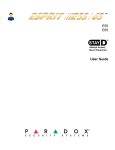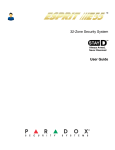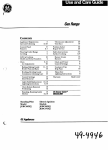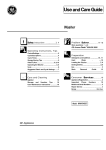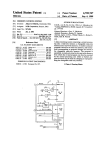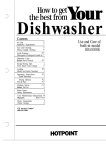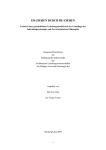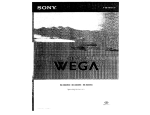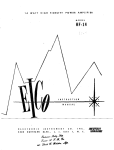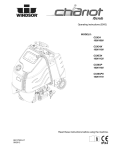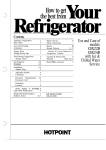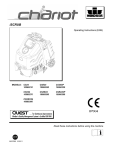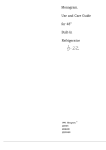Download Hotpoint CSX24X Oven User Manual
Transcript
Contenk
Appliance Registration
Base Grille
2
4
Care and Cleaning
Condenser
17
17
Diagnostic Codes
Energy Saver System
Energy-Saving Tips
Food Storage Suggestions
8,9
5
Storage Drawers
15, 16
Drawer & Cover Removal 16
13
Warranty
Back Cover
Water Filter Accessory
12
Icemaker
Installation
10-12
3,4
Extension Cord
Grounding
7
7
Temperature Controls
Vacation & Moving Tips
IO-12
Clearances
Electrical Requirements
Status Check—Reset
Warm Temperature
6-9
7
2
13
Storage Times
Ice Dispenser
Adapter Plug
Adjustable Rollers
Solid State Monitor
Door Alarm
5
18
Use and Care of
model
CSX24X
with Ice &
Chilled Water
Service
4
4
4
3,4
4
3
Location
4
Water Supply to Icemaker 4
Light Bulb Replacement
Model and Serial Numbers
Problem Solver
Repair Service
Safety Instructions
Shelves
18
2
19-21
23
3
14
me GE Answer Center”
800.626.2000
Help us
help you...
Read this book carefully.
It is intended to help you operate
and maintain your new refrigerator
properly.
Keep it handy for answers to your
questions.
If you don’t understand something
or need more help, write (include
your phone number):
Consumer Affairs
Hotpoint
Appliance Park
Louisville, KY 40225
Ene~y-saving tips
Write down the model and
serial numbers.
You’ll see them on a label at the
bottom, just inside the fresh food
compartment door.
These numbers are also on the
Consumer Product Ownership
Registration Card that came with
your refrigerator.
Before sending in this card, please
write these numbers here:
Model Number
Serial Number
Use these numbers in any
correspondence or service calls
concerning your refrigerator.
If you received a damaged
refrigerator, immediately contact
the dealer (or builder) that sold you
the refrigerator.
Save time and money.
Before you request service, check
the Problem Solver on pages 19
through 21. It lists causes of minor
operating problems that you can
correct yourself.
2
● Location of your refrigerator is
important. Avoid locating it next
to your range, a heating vent or where
the sun will shine directly on it.
● Don’t open the doors more often
than necessary.
● Close the doors as soon as
possible, particularly in hot,
humid weather.
● Be sure the doors are closed
tightly. Before leaving the house or
retiring for the night, check to be
sure the doors haven’t been left
open accidentally.
● Store only those foods requiring
refrigeration in your refrigerator.
. Wipe moisture from bottles and
cartons before putting them in the
refrigerator.
● Keep foods covered to reduce
moisture buildup inside the
refrigerator.
● If you turn the controls to the
coldest position for quick chilling
or freezing, be sure to turn them
back to regular settings.
. Don’t overcrowd your refrigerator.
Overcrowding can require extra
electrical energy to keep everything
cool.
~PORTANT S~ETY~STRUC~ONS
Read all i~rudions before@ this appliance.
W~N~When usin~ this
appliance, always exercise ba;ic
safety precautions, including the
following:
Use this appliance oniy for its
intended purpose as describd in
●
this Use and Care Book,
. This refrigerator must be
properly installed in accordance
with the Installation Instructions
before it is used. See grounding
instructions below and on page 4.
● Never unplug your refrigerator
by pulling on the power cord.
Always grip plug firmly and pull
straight out from the outlet.
● Repair or replace immediately
all electric service cords that
have become frayed or otherwise
damaged. Do not use a cord that
shows cracks or abrasion damage
along its length or at either the plug
or connector end.
G When moving your refrigerator
away from the wall, be careful
not to roll over or damage the
power cord.
● After your refrigerator is in
operation, do not touch the cold
surfaces, particularly whg hands
are damp or wet. Skin may adhere
to these extremely cold surfaces.
Do not place fingers or hands
on the automatic icem~ng
mechanism whfle the refrigerator
is plugged in. This wiii prevent
contact with the moving parts of the
ejector mechanism, or with the
heating element that releases the
cubes.
●
● Wn’t refreeze frozen foods
which have thawed completely.
The United States Department of
Agriculture in Home and Garden
Bulletin No. 69 says:
“. . .You may safely refreeze frozen
foods that have thawed if they still
contain ice crystals or if they are
still cold—below 40°F.
“. . .Thawd ground meats, poultry
or fish that have any off-odor or
off-color should not be refrozen
and should not be eaten. Thawed
ice cream should be discardd. If
the odor or color of any food is
poor or questionable, get rid of it.
The food may be dangerous to eat.
“Even partird thawing and refreezing
reduce the eating quality of foods,
particularly fruits, vegetables and
prepared foods. The eating quaiity
of red meats is affected less than
that of many other foods. Use
refrozen foods as soon as possible
to save as much of their eating
quality as you can:’
● If your old ~igerator is still
around the house but not in use,
be sure to remove the doors. This
will reduce the possibility
of danger
- to
children.
. Unplug your refrigerator:
A. Before making any repairs.
Note: We strongly recommend
that any servicing be performed
by a qualifid individual.
B. Before cleaning.
C. Before replacing a burned-out
light bulb, the refrigerator should
be unplu~ed in order to avoid
contact with a live wire filament.
(A burned-out light bulb may
break when being replaced.)
Note: ~rning control to OFF
position does not remove power
to the light circuit.
● W not operate your refrigerator
in the pmenee of ~losive fume.
Itillation Requimmenb—WO~~T...Plew madmMy.
How to connect
electricity
For pemod mfety,
t& app~ce mm be
properly grouded.
The power cord of this appliance
is equipped with a three-prong
@rounding) plug which mates with
a standard three-prong @rounding)
wall outlet (Fig. 1) to miniti the
possibility of electric shock h-d
from this appliance.
PREFERRED
METHOD
>–
,
---QQ
9
%
,.,0
- e
Where a standard two-prong wall
outlet is encountered, it is your
personal responsibility and
obligation to have it replaced with
a properly grounded three-prong
wall outlet.
?
VR
..
INSURE PROPER
GROUND EXISTS
BEFORE USE
I
Have til outlet and circuit checked
by a qualified electrician to make
sure the outlet is properly grounded.
3
T~ POWER CO~.
(continued nextpage)
Installation Requirement
Use of Adapter Plug
(U5-volt units)
a grounding type plug and outlet
and that the electrical rating of the
cord be 15 amperes (minimum) and
120 volts. Such extension cords are
obtainable through your local
service organization.
Because of potential safety
hazards under certain conditions,
we strongly recommend against use
of an adapter plug. However, if you
still elect to use an adapter, where
local codes permit, aTEMPOWRY
CONNE~ION maybe made to a
properly grounded two-prong wall
outlet by use of a UL listed adapter
(Fig. 2) available at most local
hardware stores.
The refrigerator should always
be plugged into its own
individual electrical outlet—
(115 volt, 60 Hertz, single phase
AC). This is recommended for
best performance and to prevent
overloading house wiring circuits,
which could cause a fire hazard
from overheating ‘wires.
TEMPORARY METHOD . .
(ADAPTER PLUGS NOT
PERMITTED IN CANADAI
I
n
m’
,
The larger slot in the adapter must
be aligned with the larger slot in
the wall outlet to provide proper
polarity in the connection of the
power cord.
CAUTION: Attiching adapter
ground terminal to wall outlet cover
screw does not ground the appliance
unless cover screw is metal, and not
insulated, and wall outlet is grounded
through house wiring. You should
have the circuit checked by a qualified
electrician to make sure the outlet
is properly grounded.
When disconnecting the power
cord from the adapter, always hold
the adapter with one hand. If this
is not done, the adapter ground
terminal is very likely to break
with repeated use.
Should the adapter ground
terminal break; DONOT USE the
appliance until a proper ground
has again been established.
(continued)–IMPORTANT,.. PleaSe
Refrigerator hcation
I
Do not install refrigerator where
temperature will go below 60°F.
because it will not run often enough
to maintain .proper
temperatures.
.
Do install it on a floor strong
enough to support a fully loaded
refrigerator.
Also see Energy-Saving Tips
regarding location.
Clearances
Allow the following clearances for
ease of installation, proper air
circulation, and plumbing and
electrical connections:
Sides. . . . . . . . . . . . . . . . . . . . 5/8”
Top . . . . . . . . . . . . . . . . . . . . . . . 1“
Back. . . . . . . . . . . . . . . . . . . . . . 1“
Allow the following door clearance:
Sides. . . . . . . . . . . . . . . . . . . . 3/4”
Water Supply to Icemaker
need to connect your
icemaker to a cold water line. A
water supply kit containing copper
tubinz. shutoff valve, fittings and
instructions is available at extra
cost from your deder. There should
be sufficient tubing for the icemaker
from the cold water supply to allow
you to move the refrigerator out from
the wall several feet (approximately
3 coils of l/4-inch copper tubing
that measures at least 10 inches in
diameter).
Read Carefully.
Rollers
Adjustable rollers, which enable
you to move your refrigerator away
from the wall for cleaning, are
located behind the base grille.
These rollers should be set so that
the refrigerator is firmly Positioned
on the fl;or and the frofi~is raised
just enough that the doors close
easily when opened about halfway.
Specially designed door hinges lift
both doors slightly when opened.
The force of gravity then helps
close the door automatically.
I
AT
p
‘/
.~~~ce~
,, N
##
PULL OUT
,: #
To adjust rollers, remove the base
grille by grasping it at the bottom
and pulling it out.
Turn roller adjusting screws
clockwise to raise refrigerator,
counterclockwise to lower it. Use
adjustable wrench (3/8” hex head
bolt) or pliers.
When adjusting front rollers for
proper door closure, it is recommended
that the bottom front edge of the
cabinet be approximately 5/8” from
the floor.
You will
e,
Use of Etiension Cords
Because of potential safety
hazards under certain conditions,
we strongly recommend against the
use of an extension cord. However,
if you still elect to use an extension
cord, it is absolutely necessary that
it be a UL listed 3-wire grounding
type appliance extension cord having
4
To replace base grille, align prongs
on back of grille with clamps in
cabinet and push forward until
grille snaps into place.
Opemting Your Refrigemtor
Set the
Temperature Controk
Automatic
Energy Saver System
I
You won’t find an “energy saver”
switch on this refrigerator.
Warm liquid from the refrigerator’s
condenser is automatically circulated
around the front edge of the freezer
compartment to help keep moisture
from forming on the outside of the
refrigerator during humid weather.
Many refrigerators use special
electric heaters. This refrigerator
needs none. That’s why there is no
“energy saver” switch. . there’s no
need for it.
TEMPERATURE CONTROLS
Your refrigerator has two controls
that let you regulate the temperature
in the fresh food and freezer
compartments.
INITIALLY, set the FRESH
FOOD control at 5 and the
FREEZER control at C.
For colder or warmer temperatures,
adjust the desired compartment
control one letter or number at
a time.
IMPORTANT
When initially setting the controls,
or when adjusting them, allow 24
hours for the temperatures to
stabilize, or even out. Do this before
filling the refrigerator with large
amounts of fresh or frozen foods.
Note: Turning the fresh food
control to “OFF” stops cooling in
BOTH compartments-fresh food
AND freezer—but does not shut
off power to the refrigerator.
How to Test Temperatures
Use the milk test for the fresh
food compartment. Place a
container of milk on the top shelf in
the fresh food compartment. Check
it a day later. If the milk is too
warm or too cold, adjust the
temperature controls.
I
Use the ice cream test for the
freezer compartment. Place a
container of ice cream in the center
of the freezer compartment. Check
it after a day. If it’s too hard or too
soft, adjust the temperature controls.
Always allow 24 hours for the
refrigerator to reach the
temperature you set.
If you turn your
household thermostat
below 60°F. at night
. . . you may want to turn the fettered
control one step colder, as from “C”
to “D?’ Cooler temperatures in the
house may cause the compressor to
operate less frequently, thus
allowing the freezer compartment
to warm somewhat. To protect your
frozen food supply, leave your
lettered setting at this colder setting
for the entire winter or for whatever
period of time you are turning down
your thermostat. This is especially
important when the thermostat is
turned down for an extended period.
This change should have no effect
on your fresh food compartment.
However, if freezing occurs, turn
the numbered control one step
warmer, as from “5” to “4?’
When you stop turning the
thermostat down, turn temperature
controls back to their regular
settings.
5
No Defrosting
It is not necessary to defrost the
freezer or fresh food compartments.
Your refrigerator is designed and
equipped to defrost itself
automatically.
Solid State Monitor System
It keeps an eye on
things for you.
@Red signal light flashes to tell
you when either door is open.
@Green signal light tells you[hat
the Door Alarm beeper has been
set to sound after either door has
been open 30 seconds.
What these codes mean—and
what to do when they appear—is
summarized on the inside of the
freezer compartment door and
explained more thoroughly on
the following pages.
@ Status Check pad puts a review
@Red signal light tells you when
freezer foodkeeping temperature is
above normal.
@Green lighted word NORMAL
indicates that no failure has been
detected by the diagnostic system.
@Flashingdiagnosticcodes in the
display warn you when:
frozen foods should be
❑
checked.
m
power has been interrupted.
E
icemaker may not be operating
❑
properly.
❑defrost system has failed.
❑
freezer control may need to be
set for a
-
colder temperature.
of the electronic diagnosis of five
coded functions at your fingertip
and also allows you to erase codes
from display.
@ Electronic control allows you
to turn night light in water-and-ice
service on and off.
When your refrigerator
is first plugged in.. .
All panel lights come on for five
seconds, a beep sounds, and lights
go off except as follows:
● PF tlashes in the display. Touch
STATUS CHECK-RESET pad to
erase it.
● Green word NORMAL glows.
● Red WARM TEMPERATURE
light glows if freezer compartment
temperature is higher than normal.
It goes off when proper foodkeeping
temperature is reached.
● Door alarm beeper is activated
and green light on DOOR ALARM
pad glows.
● Red DOOR OPEN I ight flashes if
either door is open, goes out when
doors are shut.
. Night light in water-and-ice
service is off.
How to Set the
Door Alarm
Why the Red Warm
Temperature Light G1OWS
You don’t have to set the visual
alarm. As long as either door is
open. the red DOOR OPEN signal
light flashes.
At first, it’s probably because your
newly installed refrigerator hasn’t
completely cooled down yet. Wait
a few’ hours for it to coo], and then
the I ight will go out.
How the Solid State
Monitor System Work
The word NORMAL is lighted
in green except when a failure has
been detected.
If the green signal light on the
DOOR ALARM pad is glowing,
the beeper alarm is set. If it’s not,
touch the pad to turn it on.
From then on, the red light will
glow whenever temperatures inside
get too high for proper food stor~.ge.
If this happens, open the doors
only when absolutely necessary,
and close them as quickly as
possible.
As soon as inside temperatures
return to normal, the I ight goes out.
If either door is open for more than
30 seconds;, a recurring beep sounds.
The light goes out and the beeping
stops when you close the door.
The STATUS CHECK-RESET pad
has two functions:
1. You can touch the STATUS
CHECK-RESET pad and get a
There are times when you’ll want
the Door Alarm beeper turned
off. When you’re rearranging a lot
of food, for example. Just touch the
pad. The green light will go out
and the beeping will stop.
Deactivating the Door Alarm
beeper does not turn the red DOOR
OPEN light oft-it keeps flashing
until the door is closed.
review of the electronic diagnostic
codes in order of their priority.
2. You can touch the STATUS
CHECK-RESET pad to erase three
flashing codes immediately. Two
codes (DE and FF) cannot be erased
until the condition that caused them
to flash has been corrected (see
page 8).
(continued next page)
7
Solid Sbte Monitor System (continued)
The Solid State Monitor System
alerts you when something starts to
go wrong.
If a diagnostic code appears on
the display, something needs
special attention. To get your
attention, the display code flashes
until you erase it. The first 6
flashes are accompanied by beeps.
If more than one coded function
requires attention at the same
time, the one with the highest
priority will be displayed first.
Pressing the STATUS CHECKRESET pad will evaluate all other
coded functions. If the NORMAL
display is lit during the displaying
of a code, that function is operating
properly.
Pressing the STATUS CHECKRESET pad will erase three codes
immediately—PE Cl and CC.
The DE and FFcodes can only be
erased by touching the STATUS
CHECK-RESET pad after the
condition that caused the code to
flash has been corrected.
This flashing code tells you to
check your frozen food. Has any
of it started to thaw’? A package
may be holding the freezer
compartment door open. Don’t
open the door more often than
absolutely necessary while this
code is displayed. Touching the
STATUS CHECK-RESET pad
after the freezer compartment
temperature has returned to
normal will erase the code.
This flashing code tells you the
power to the refrigerator has
been interrupted for more than 2
seconds. Check the condition of
food in both the fresh food and
freezer compartments. Touch
STATUS CHECK-RESET pad
to erase code.
This flashing code tells you
something’s wrong with the defrost
system—keep doors closed to
retain cold and call for service.
Code flashes until problem is
corrected.
There is no fault with the
refrigerator when PF code
flashes.
This flashing code tells you to
check the automatic icemaker.
Ice clumps in the storage bin may
have stalled the icemaker. Follow
corrective measures described on
page 12. If water supply to the
icemaker is not connected or not
turned on, make sure manual
icemaker switch is in the OFF
position (see page 10). Code stops
flashing when problem is corrected
or STATUS CHECK-RESET pad
is touched.
8
This flashing code tells you to
check temperature controls and
adjust them if necessary. (See
directions on page 5.) Touch
STATUS CHECK-RESET pad
to erase code. If code reappears
after 4 hours. call for service.
Signal Lights and
Diagnostic Codes
What they mean, and what
to do when they alert you, is
summarized on this panel
on the inside of the freezer
compartment door.
Panel lo<ated on the inside of the freezer compartment door
Ice & Chilled Water Dispemer
Automatic Icemaker and
Ice & Water Dispenser
Your refrigerator has an automatic
icemaker and a dispenser that
dispenses chilled water and ice
cubes through the freezer
compartment door. Here’s how
they work.
Importint Facfi about
Your Ice &Water Dispenser
Your icemaker will produce eight
cubes per cycle—approximately
120 cubes in a 24-hour period—
depending on freezer compartment
temperature, room temperature,
number of door openings and other
use conditions.
● Intermittent dispensing of ice is
normal. If ice flow interruption is
●
more than brief, ice clump(s) may
be the cause and should be removed
following instructions below and
Before Using Your
Icemaker and Dispenser
If you use your refrigerator before
the water connection is made, raise
the ice access door and make sure
the icemaker feeler arm is in the
OFF (up) position as shown below.
I
Ice access
door
h
Icemaker
->
*
on page 12.
Q Avoid overfilling glasses with
ice and using narrow or extra-tall
glasses. This can jam the chute or
cause the door in the chute to freeze
shut. Periodically open the freezer
compartment door and look down
Water flows from the household
supply through a
(1) dual solenoid valve to the
(2) water reservoir and to the
(3) automatic icemaker as needed.
Water is frozen in the
(4) cube mold and ejected into the
(5) storage bin where a motorpowered auger moves cubes
forward into the dispensing unit.
When the ICE CUBES cradle is
pressed, cubes dispense through
the chute in the door.
When the CHILLED WATER
cradle is pressed, chilled water
from the reservoir flows through the
(6) tubing in the door and is
dispensed.
(7) A light switch turns the night
light in the dispenser on or off.
into the chute. If ice is blocking
the chute, poke it through with a
wooden spoon.
. To help keep bits of ice from
being sprayed beyond the giass,
place glass close to ice chute—
but not so close that it blocks
outcoming ice.
. Ice should not be dispensed
into thin glasses, fine china or
delicate crystal-they can crack or
chip from the combined pressure of
your hand pressing them against the
cradle and ice dropping into the
container.
● Ice should be dispensed before
filling glass with soda or other
beverage mixes. This will prevent
splashing which is annoying and
which, if the splash reaches the ice
and water selector switch, could
cause it to stick or bind.
. Beverages and foods should not
be quick-chilled in the ice storage
bin. Cans, bottles or food packages
in the storage bin may cause the
icemaker to malfunction.
. Ice other than that produced
by your icemaker should not be
added to the ice storage bin—it
may not dispense well.
10
in
When water supply has been
connected to icemaker, move feeler
arm to ON (down) position.
Depress water dispenser cradle for
about two minutes to remove
trapped air from water I ine and to
fill water reservoir automatically.
Ice cube mold automatically fills
with water after cooling to freezing
temperatures. First cubes normally
freeze after several hours.
NOrE: With a newly-installed
refrigerator, allow about 24 hours
for the freezer compartment to cool
down to the proper icemaking
temperature.
Once Your Icemaker and
Dispenser Are in Operation
Throw away the first few batches
of ice cubes (16 or 24 cubes). This
will flush away any impurities in
the water line. Do the same thing
after vacations or extended periods
when ice isn’t used.
Discard the first six glassfuls of
water in the kitchen sink. This will
eliminate the slight “plastic” taste
temporarily imparted to the water
by the water reservoir.
Keep ice level to keep icemaker
productive. Cubes ejected into
an empty storage bin will pile up
close to the icemaker and push the
feeler arm up to the OFF position
prematurely when the bin is only
partially full. Open the ice access
door, reach in, level the cubes by
hand and icemaking will resume.
Keeping cubes distributed evenly
will allow the icemaker to produce
enough ice to fill the bin to its
maximum capacity.
Caution:
Under certain rare circumstances,
ice cubes may be discolored,
usually appearing with a greenbluish hue. The cause of this
unusual discoloration is apparently
due to a combination of factors
such as certain characteristics of
local waters, household plumbing
and the accumulation of copper
salts in an inactive water supply
line which feeds the icemaker.
Continued consumption of such
discolored ice cubes may be
injurious to health. If such
To Dispense Ice and Water
To Stop Dispensing
For ice, simply position glass
beneath words ICE CUBES. For
water, position glass beneath
words CHILLED WATER.
Release pressure from cradle and
withdraw slowly to catch last ice
cubes or drops of water.
Some slight dripping may occur
following dispensing of chilled
water. If excessive, the spill should
be wiped dry immediately.
Do not pour water in spill shelf
because it is not self-draining—
pour it in kitchen sink. The shelf
and its grille should be cleaned
regularly according to instructions
on page 17.
●
II
w
When Dispeming Water...
The water system provides
approximately six successive
6-ounce glassfuls—after which
several hours must be allowed for
replenished water reservoir supply
to cool. You probably will not drain
all the chilled water from the
reservoir on a single occasion.
1’
1
The first glass of water dispensed
may be warmer than the following
ones. This is normal.
Dispensed water is chilled, not
iced. For colder water, simply add
ice before dispensing water.
● Grip glass or other container
gently near the rim and press rim
firmly against ice or water
dispenser cradle.
(continued next page)
discoloration is observed, discard
the ice cubes and contact your
Hotpoint Factory Service Center
or an authorized Customer
Care” Servicer.
11
Ice & Chilled Water Dispemer
(continued)
If Ice Clumps Form in
Storage Bin...
To Replace Ice Cube
Storage Bin...
Water Filter
Icemaker Accessory -
The Icemaker ejects cubes in
groups of eight, and it is normal for
several cubes to be joined together.
However, if you don’t use the ice
very often, ice clumps may form in
the storage bin and can clog the
dispenser.
Slide the bin back until the @bon
the bin locks into the slot in the
shelf.
Your ice cubes can only
be as fresh-tasting as the
water that produces
them. That’s why it’s a
good idea to purify your
water with a water filter.
If this happens:
● Remove storage bin from freezer
compartment.
● Break up ice clumps with
fingertip pressure and discard
remaining clumps.
● Replace bin before remaining
cubes melt and fuse together.
To Remove Ice Cube
Storage Bin...
n
Rotate
~
e~
Drive
Mechanism
If bin does not go all the way
back, remove it and rotate the drive
mechanism 1/4 turn. Then push bin
back again until the tab on the bin
locks into the slot in the shelf.
If Ice h Not Used Often . . .
Old ice cubes will become cloudy
and taste stale. Empty ice storage
bin periodically and wash it in
lukewarm water. Be sure to allow
storage bin to cool before replacing
it—otherwise ice cubes will stick
to the metal auger.
Move Icemaker Feeler Arm
to OFF (up) Wtion when . . .
Lift the left corner to free the bin
from the shelf, and pull the bin
straight out while supporting it at
front and back.
● Home water supply is to be
turned off for several hours.
● Ice storage bin is to be removed
for a period of time.
● Going away on vacation, at which
time you should also turn off the
valve in the water supply line to
your refrigerator.
If This is Your First
Icemaker...
You’ll hear occasional sounds that
may be unfamiliar. These are normal
icemaking sounds and are not
cause for concern.
12
Its activated charcoal
removes musty, stale
odors and unpleasant
medicinal, metallic
tastes. A porous fiber
cartridge catches dirt,
rust particles, sand and
silt while special crystals
reduce deposits of hard scale.
The filter is an option at extra
cost, available from your Hotpoint
dealer. Specify WRWX214. It has
complete installation instructions
and installs in minutes on 1/4” O.D
copper water line.
Food Storage Su~estions
Ii) store cheese, wrap well with wax
Su~ested storage times
for meat and poultry*
IN
REFRI;!RATOR
Eating quality drops
after time shown
paper or aluminum foil, or put in
a pl:istic bag.
FREEZER
AT
O°F.
MONTHS
35° t:T400F.
DAYS
Fresh Meats
Roasts (Beef & Lamb)
Roasts (Pork & Veal)
Steaks
(Beef)
Chops (Lamb)
Chops
(Pork)
Ground & Stew Meats
Variety
Meats
Sausage (Pork)
3 I(1 5
3 [0 5
3 to 5
3 to 5
1 ti; 2
1 to 2
1 to 2
1 to 2
5 to 12
4 to 8
6 [0 12
7
7
7
3 1[) 5
3
3 tc 5
1
1,/2
I 102
1 to 2
1 [02
Freez\ng
6 to 9
: t:) A
3104
3 !(! 4
1102
Processed Meats
Bacon
Frankfurters.
Ham (Whole)
Ham
(Half)
Ham (Slices)
Luncheon
Meats
Sausage(Smoked)
Sausage (Dry & Semi-Dry)
OOi (CCO~)-
14 t: 21
mended
Cooked Meats
Cooked Meats and
Meat Dishes
Gravy & Meat Broth
3 to 4
1 to 2
? IO 3
2 tn 3
1 to 2
1 to 2
i tO 2
1 to 2
1 to 2
II
:)
6
6
3
Cooked Poultry
Pieces (Covered with Brett
Pieces (Not Covered)
Cooked Poultry Dishes
Fried Chicken
C;arefLIlly wrap to expel air and
pl”evcnt mold.
● Store
pre-packaged cheese in its
own wrapping if you wish.
To store vegetables, use the
vcgctablc ttrawcrs—they ’vc been
designed to preserve the natural
n)oist urc and freshness of produce.
● Covcri ng vegetables with a moist
towel helps maintain crispness.
o As a furtbcr aid to freshness,
pre -pac’kag(:d vegetables can be
slorcd in their original wrapping.
IV(~t(J.’
771(’ .$’(’(ll(~il &
Fr(’.vh (ir(li~~(’r
t)l(lk(~,v il litltl~’( ‘<’.$,$~lrj l{) wlrur] ~“e~uirl
,~i),)~l.~ }tllitll it }IIJ.$ I;t[tl ~1[~.jigrlt~d l{]
l~t-t’,j(’r~t’. 771i.\ {ir~l~vt)r i.s (1(’.~(rih(~d
(Jtl l)(lc~(’ 15,
Fresh Poultry
Chicken & Turkey (Whole)
Chicken (Pieces)
Turkey (Pieces)
Duck & Goose (Whole)
Giblets
●
bclp
~
1 to 2
3 to 4
3 to 4
3 to 4
I
410 C
4
(Otherthan formeats &poultry)
FREEZER
Most fruits and vegetables
3.12
Lean fish
Fatty fish, rolls and breads,
soups, stew, casseroles
Cakes, pies, sandwiches,
leftovers (cooked),
Ice cream (original cart{] r!)
68 rnonlhq
r(lullth:;
23 mofllil!:
1 montlj max.
New techniques are constantly being developed
Consult the College or County Extension Service
or your local Utility Comp?ny foi the latest
information on freezing and storing foods.
‘U.S. Depa/7metri of Agriculture
To store ice ereanl—Fine-quality ice
L’rcum. with high cream content, will
norm; al Iy require slightly lower
tcnlpcrut(lr~:s than more “tiiry”
;Ilrt’iidy-p:ick ageci brands with
low crciml content.
~ tt Wi I I be necessary to experiment to
delerminc the freezer compartment
location” and temperature control
sctt ing to keep your icc cream at
[tic right s(:rv ing temperature.
Tbc rear of the freezer compartment
is slightl} cotder than the front.
●
Tips on freezing foods
“~hcrl? arc three csscnt ial
r(’qulr~’i)lc>n(s Ii)r cfl’icient home
I’[t’cziny:
Meats, fish and poultry purcbasc~i
from the store ~:lry in quuiitj’ and
age; ~~)ns~q ucn(ly. S:lli’ S((ll’il~L’
time in your rcfrigcr:tlor W ill
Viir:
To store unfrozen meats, fish and
poultry:
Q Always renlo~e store w r:ippi J ::,[s.
● Rewrap i n foi 1. ii l~rl or wu x p:tpc r
and refrigerate imnled iatcl:~.
1.3
—
To freeze meat, fish and poultry,
wrap well in freezer-weight foil (or
other heavy-duty wrapping material)
forming it carefully to the shape of
the contents. This expels air. Fold
and crimp ends of the package to
provide a good, lasting seal.
Don’t refreeze meat that has
completely thawed; meat, whether
raw or cooked, can be frozen
successfully only once.
Limit freezing of fresh (unfrozen)
meats or seafoods to 26 pounds at
a time.
For convenience...
● Store all like things together. This
not only saves time, but electricity—
because you can find foods faster.
. Place the oldest items up front so
they can be used up promptly.
● Use shelves on the door for most
often used sauces and condiments.
● Use the meat drawer for meats
you do not freeze.
To save money in ene~y
and food costi:
● Place most perishable items, such
as milk, cream or cottage cheese,
toward the rear of the top shelf;
they will stay coldest in this part of
the fresh food compartment.
● Cover moist foods with tight lids,
plastic film or foil.
● Leaf vegetables and fruits
placed in storage drawers will last
longer when stored in closed plastic
containers or wrapped in plastic film.
s Do not overload your fresh food
or freezer compartment with a lot
of warm food at once.
● Open the door the fewest times
possible to save electrical energy.
● When going out of town for
scvcra] days, leave as few perishables
as possible in the refrigerator. Set the
icem:iker to the OFF position and
shut off water to the refrigerator.
Shelves
Shelves in the fresh food and
freezer compartments are adjustable,
enabling you to make efficient shelf
arrangements to fit your fdmily ’s
food storage needs.
Removable Bins on Fresh
Food Compartment Door
Removable Shelves in
Freezer Compartment
Shelves in the freezer compartment
are easily removed and replaced.
To remove shelves:
Adjwtible Shelves in
Fresh Food Compartment
To remove bins: Lift bin straight
up until mounting hooks disengage.
To remove shelves: Tilt shelf up
at front, then lift it up and out of.
tracks on rear wall of refrigerator,
To relocate bins: Select desired
bin height. engage hooks in slots on
the tracks of the door, and push in.
Bin will lock in place.
To replace shelves: Select desired
shelf height. With shelf front raised
SI ightly, engage top lugs in tracks at
rear of cabinet. Then lower front ot”
shelf until it locks into position.
1. Whiie pressing tabs on shelf
supports on right wall, lift shelf out
of grooves in supports.
2. Pull shelf sideways until rods
come out of holes on left wall.
To replace shelves: Insert rods into
holes. Then, while pressing tabs,
lower shelf into grooves in supports.
Be sure shelf wire is fully inserted
into grooves.
14
Storage Drawers
Convertible Meat Keeper
Sealed & Fresh Drawer
The Convertible Meat Pan drawer
has its own cold air duct to allow a
stream of cold air from the freezer
compafiment to flow around the
drawer.
The variable temperature control
regulates the air tlow from the
freezer compartment.
This refrigerated drawer is designed
to keep unwrapped foods fresh by
retaining the natural moisture
content of foods such as:
. Artichokes
● Cherries
● Plums
● Asparagus
● Corn
Beets, topped . Currants
● Blueberries
● Greens, leafy
● Lettuce
● Carrots
. Parsley
● Celery
● Peas, green
●
Set control lever to MEATS—the
coldest setting-to store fresh meats.
If lever is left in MEATS position for
a long period of time, some frost may
form on the inside of the drawer.
Set control lever to VEGETABLES
to convert the drawer to normal
refrigerator temperature and
provide extra vegetable storage
space. Cold air duct is turned off.
Variable settings between these
extremes can be selected.
● Radishes
● Rhubarb
●
Spinach
● Tomatoes,
ripe
As in any refrigerated storage area,
it is recommended that odorous
foods be stored wrapped–foods
such as:
● Broccoli
. Brussels
Sprouts
● Cabbage
● Parsnips
● Cauliflower
● Turnips
● Green
Onions
Storage time will depend upon the
type of food and its condition when
placed in the drawer.
Excess water which may accumulate
in the bottom of the Sealed & Fresh
Drawer should be poured out and
the drawer wiped dry.
The Sealed & Fresh Drawer is
partially sealed by gaskets attached
to the cover at the front and back
edges. Always replace the drawer
in this cover and push the drawer
all the wa~~ in.
15
To Remove Dmwers
\l
Ill,
,,
-,
1. Remove food from the shelf
above the Sealed & Fresh drawer
and take out the shelf. Take food off
the glass cover and out of the drawer.
2. Put your fingers behind the
gasket at the rear of the drawer and
pull forward. Remove the gasket.
8. Tilt and rcmove the drawer.
After clean ing, replace in reverse
order.
5. Pull the drawer forward, lift the
front to clear stops, and remove the
drawer. Ifthc refrigerator door
doesn’t open completely. pull the
drawer out until it hits the door.
Then lift the drawer up until it is
higher than the drawer supports.
tilt it and take it out.
6. If tape holds Convertible Meat
Pdn cover to drawer supports, remove
the tape. Pull drawer partway out.
Reach in, push the rear of the glass
up and, at the same time, back, until
it clears front-corner” retainers.
3. Pull the drawer partway out.
Reach in, push the rear of the glass
up; at the same time, push it back
,
until it clears front-corner retainers.
When drawers and covers are back
in place. reinstall the gasket at the
rear of the Sealed & Fresh drawer.
Fit the end of the plastic drawer
support into the slot on the gasket,
with the rubber gasket fl:Ip facing
you. Make sure the gasket snaps
into place.
4. Tilt and remove the cover.
L
II
7. Tilt and remove the cover.
10
1
I
Care and Cleaning
Cleaning—Outside
Cleaning—Inside
Behind Refrigerator
Solid state monitor system
panels. Clean the panels on the
outside and inside of the freezer
compartment door with a soft,
clean cloth lightly dampened with
water. Do not use cleaning sprays
or large amounts of water—the
liquid can run down and damage
the control mechanisms.
Inside the fresh food and freezer
compartments should be cleaned at
least once a year. Unplug the
refrigerator before cleaning. If
this is not practical, wring excess
moisture out of sponge or cloth
when cleaning around switches,
lights or controls,
Use warm water and baking soda
solution—about a tablespoon of
baking soda to a quart of water. This
both cleans and neutralizes odors.
Rinse thoroughly with water and
wipe dry.
Other parts of the refrigerator—
including door gaskets, meat and
vegetable drawers, icc storage
bin and all plastic parts-can be
cleaned the same way. Do not use
cleansing powders or other abrasive
cleaners.
To help prevent odors, leave
an open box of baking soda in the
rear of the refrigerator, on the top
shelf. Change the box every three
months. An open box of baking
soda in the freezer will absorb
stale freezer odors.
Care should be taken in moving
your refrigerator away from the
wall. All types of floor coverings
can be damaged, particularly
cushioned coverings and those
with embossed surfaces. Pull the
refrigerator straight out and return it
to position by pushing it straight in.
Moving your refrigerator in a side
direction may result in damage to
your floor covering or refrigerator.
The water and ice dispenser
spill shelf should be wiped dry
immediately to prevent spotting,
Water left on the shelf may leave
deposits that you can remove by
soaking in undiluted vinegar.
Y[Ju can also use a paste of
non-precipitating water softener
(such as Calgon brand) and water,
or one teaspoon of citric acid
powder per pint of hot tap water.
Soak until the deposit disappears or
becomes loose enough to rinse
away. Usually 30 minutes soaking
time is adequate. Avoid using wax
on the spill shelf and trim.
The door handles and trim can
be cleaned with a cloth dampened
with a solution of mild liquid
dishwashing detergent and water.
Dry with a soft cloth. Don’t use
wax on the door handles and trim.
Keep the finish clean. Wipe with
a clean cloth lightly dampened
with kitchen appliance wax or mild
liquid dishwashing detergent. Dry
and polish with a clean, soft cloth.
Do not wipe the refrigerator with
a soiled dishwashing cloth or wet
towel. These may leave a residue
that can erode the paint. Do not use
scouring pads, powdered cleaners.
bleach or cleaners containing bleach
because these products can scratch
and weaken the paint finish.
fiotect the paint finish. The finish
on the outside of the refrigerator is a
high quality, baked-on paint jinish.
With proper care, it will stay ncwIooking and rust-free for years.
Apply a coat of kitchen/appliance
wax when the refrigerator is new
and then at least twice a year.
Appliance Polish Wax & Cleaner
(Cat. No. WR92X216) is available
from Hotpoint Appliance Parts
Marts.
Do not wash any plastic parts
from your refrigerator in your
automatic dishwasher.
Drain opening in freezer
compartment. During yearly
cleaning, remove bottom freezer
basket and flush a solution of
baking soda (one teaspoon) and two
cups of hot (not boiling) water
through the drain line with the help
of a meat baster. This will help
eliminate odor and reduce the
likelihood of a clogged drain line.
If drain becomes
clogged, use a
,1
-—-.
-I;
meat baster and
b “s==
baking-soda-and‘“ ‘“water solution to
m
‘-—
force the clog
through the
[-””””-4[
drain line.
Continue flushing until line is clear,
then empty and replace the defrost
water pan immediately.
17
Condenser
The condenser is located behind
the base grille. For most efficient
operation you need to keep the
condenser clean. Remove the base
grille (see page 4) and either sweep
away or vacuum up dust that is
readily accessible. This easy
cleaning operation should be done
at least once a year.
Conde-nser
Defrost Water Wn
Pan behind base grille should be
cleaned at least once a year. When
reinstalling pan, firmly push it
ALL THE WAY IN until it stops.
Defrost water pan
Care and Cleaning (continued)
Light bulb
replacement
In Fresh Food Compartment
1. Unplug refrigerator.
2. To align the control knob
properly, note position of
numbered control for proper
reassembly and pull off knob.
3. Pull bottom of light panel down
about l/4’’—just enough to disengage
lip at rear from grooves in retainers
on rear wall.
4. Lift panel to disengage top from
pins on side walls; remove panel.
After replacing with same size
bulb, reinstall panel (hang top on
pins; pull bottom down, push it
back and release it to let lip engage
grooves in retainers). Replace
temperature control knob in OFF
position, turn it to previous setting,
and plug refrigerator back in.
,
.
,
.
m
In Freezer Compartment
1. Unplug refrigerator.
2. Remove shelfjust below light
shield. (Shelf will be easier to
remove if it is emptied first. )
3. Pull plastic light shield toward
you. (It will bend to free tabs from
grooves.)
After replacing with same size
bulb, reinstall shield and shelf and
plug refrigerator back in.
When you goon
vacation
For extended vacations or
absences, shut off power to
refrigerator, turn the numbered
control to OFF, clean interior with
baking soda solution of one
tablespoon of soda to one quart of
water. Wipe dry. To prevent odors,
leave open box of soda in
refrigerator. Leave doors open.
For shorter vacations, remove
perishable foods and leave controls
at regular settings. However, if
room temperature is expected to
drop below 60°F., follow same
instructions as for extended
vacations.
Move icemaker feeler arm to OFF
(up) position and be sure to shut off
water supply to the refrigerator.
When you move
Disconnect power cord from wall
outlet, remove all food and clean
and dry the interior.
Secure all loose items such as
grille, shelves and storage pans by
taping them securely in place to
prevent damage.
Be sure refrigerator stays in upright
position during actual moving and
in van. Refrigerator must be secured
in van to prevent movement. Protect
outside of refrigerator with blanket.
18
Rapid Electrical Diagnosis
m
-
Questiom?
~
- Use This Problem Solver
Y(]ur refrigerator is wired for accurate
electrical diagnosis in your home—takes
only minutes for a service technician to
check itsentireelectrical system. No need for
the technician to unplug, move or unload
the refrigerator to make the diagnosis.
PROBLEM
POSSIBLE CAUSE AND REMEDY
NO PANEL ~UCH
PAD RESPONSE
If interior light is not on, refrigerator may not be plugged in at wall outlet.
If plug is secure and the refrigerator still fails to operate, plug a lamp or a small
appliance into the same outlet to determine if there is a tripped circuit breaker or
burned out fuse.
REFRIGERATOR
DOES N~ OPERATE
May be in defrost cycle when motor does not operate for about 30 minutes.
● Temperature control in OFF position.
● If interior light is not on, refrigerator may not be plugged in at wall outlet.
● If plug is secure and the refrigerator still fails to operate, plug a lamp or a small
appliance into the same outlet to determine if there is a tripped circuit breaker or
burned out fuse.
M~R OPERATES
FOR LONG PERIODS
● Modern refrigerators with more storage space and a larger freezer compartment
require more operating time.
● Normal when refrigerator is first delivered to your home—usually requires 24 hours
to completely cool down.
● Large amounts of food placed in refrigerator to be cooled or frozen.
● Hot weather—frequent door openings.
● Door left open.
● Temperature controls are set too cold. Refer to instructions for use of
TEMPERATURE CONTROLS on page 5.
● Grille and condenser need cleaning. Refer to page 17.
● Check ENERGY-SAVING TIPS on page 2.
M~R STARTS&
S~PS FREQUENTLY
●
VIBRATION OR
RATTLING
●
HOT AIR FROM
BOT~M OF
REFRIGERA~R
● Normal air flow cooling motor. In the refrigeration process, it is normal that heat be
expelled in the area under the refrigerator. Some floor coverings will discolor at these
normal and safe operating temperatures. Your floor covering supplier should be
consulted if you object to this discoloration.
DOOR NOT CLOSING
● Door gasket on hinge side sticking or folding over. To correct, put a small amount of
petroleum jelly on face of gasket.
PROPERLY
●
●
●
Temperature control starts and stops motor to maintain even temperatures.
If refrigerator vibrates, more than likely it is not resting soiidly on the floor and front
roller screws need adjusting or floor is weak or uneven. Refer to ROLLERS on page 4.
● If dishes vibrate on shelves, try moving them. Slight vibration is normal.
● Defrost water pan rattling, needs to be positioned properly.
((,IfIt;nuc,d nc,xt page)
19
The Problem Solver
(continued,
PROBLEM
POSSIBLE CAUSk; AND RK;hlElj}’
OPERATING SOUNDS
Q The high speed compressor motor required to maintain near zero temperatures in the
large freezer compartment may produce higher sound levels than your old refrigerator.
● Normal fan air flow-one fan blows cold air through the refrigerator and freezer
compartments, another fan cools the compressor motor.
●
FRESH FOOD
OR FREEZER
COMPARTMENT
TEMPERATURE
TOO WARM
These NORMAL sounds will also bc heard from time [o time:
c Defrost timer switch clicks at defrost.
● Defrost water dripping into drain pan.
● Temperature control clicks ON or OFF.
● Refrigerant boihng or gurgling.
● Cracking or popping of cooling coils caused by expansion and contraction during
defrost and refrigeration following defrost.
● With automatic iccmaker, the sound of cubes dropping into the bin and water
running in pipes as icemaker refills.
● Temperature control not set cold enough. Refkr to TEMPERATURE CONTROLS
on page 5.
●
Warm weather—frequent door openings.
. Door left open for too long t inlc.
Package may be holding door open.
————
c Foods not covered, wrapped or sealed properly.
●
FOODS DRY OUT
FROST OR lCE
CRYSTALS ON
FROZEN FOOD
. Door may have been left ajar or package holding door open.
. Too frequent and too long door openings.
c Frost within package is normal.
SLOW ICE CUBE
FREEZING
. Door may have been left ajar.
ICE CUBES HAVE
ODOR/TASTE
●
. Turn temperature of freezer compartment colder.
Old cubes need to be discarded.
. Ice storage bin needs to be cmptied or washed.
. Unsealed packages in refrigerator and/or Ircezer compartments may be transmitting
odor/taste to ice cubes.
AU~MATIC
ICEMAKER
DOES NOT WORK
●
Interior of refrigerator needs cleaning-refer to page 17.
●
Poor-tasting incoming water. Install water filter—see page 12.
. Icemaker feeler arm in OFF (up) position.
●
Water supply turned off or not connected.
●
Freezer compartment too warm.
s Cubes too small—water shutoff valve conrlecting refrigerator to home water line may
be clogged.
● Sometimes cubes fuse to the side oj’ the ice mold and holcl the feeler arm in the OFF
(up) position. Remove this ice to restart ?he iccmakcr.
. When reaching for cubes by hand, y~)u may have pl.lshcd the feeler arm into the OFF
(up) position by mistake.
. Piled up cubes in storage bin may cause icemaker lo shut off prematurely. With
icemaker feeler arm in OFF (up) position, level cubes in bin by hand.
—.—.
20
PROBLEM
POSSIBLE CAUSE AND REMEDY
CUBE DISPENSER
. No ice cubes. Remove storage container. If cubes are frozen to wire arm, remove
cubes.
. No ice cubes. Icemaker turned off or water supply turned off.
DOES NOT WORK
● Irregular ice clumps in storage container. Breakup as many as you can with fingertip
pressure and discard the remaining clumps.
WATER HAS POOR
TASTE/ODOR
● If water dispenser has not been used for an extended period, dispense water in regular
manner until all water in reservoir is replenished with fresh water.
● Poor-tasting incoming water, Install a water filter-see page 12.
WATER IN FIRST
GLASS IS WARM
. Allow about 24 hours for water to cool to proper temperature after refrigerator is
first installed.
● If water dispenser has not been used for extended period, water in first glass will not
be as cool as in succeeding glasses.
●
If water reservoir has been drained, allow several hours for replenished supply to chill.
WATER DISPENSER
DOES NOT WORK
. Water supply line turned off or not connected.
● Supply line maybe clogged with sediment.
DIVIDER BETWEEN
FRESH FOOD AND
FREEZER COMPARTMENTS FEELS WARM
● Normal warmth is created by automatic energy saver system circulating warm liquid
around front edge of freezer compartment to help prevent condensation on outside of
refrigerator in hot, humid weather.
MOISTURE FORMS
ON OUTSIDE OF
REFWGERATOR
●
Not unusual during period of high humidity.
MOISTURE
COLLE~S INSIDE
Too frequent and too long door openings.
● In humid weather air carries moisture into refrigerator when doors are opened.
WATER ON KI~HEN
FLOOR OR ON
B~~M OF
FREEZER
● The drain in the bottom of the freezer maybe clogged. Remove any ice on the freezer
bottom and clean the drain. Refer to page 18.
● If you use a glass over 6 inches tall, you may be jamming cubes in the funnel chute.
They can fuse inside the chute and drop out later, leaving water or ice on the floor.
● Defrost water pan full, missing or not in position.
REFRIGERATOR
HAS ODOR
INTEMOR LIGHT
DOES N~ LIGHT
●
Foods with strong odors should be tightly covered.
● Check for spoiled food.
● Interior needs cleaning. Refer to page 17.
● Defrost water pan needs cleaning.
● Keep open box of baking soda in refrigerator; replace monthly.
●
●
No power at outlet.
●
Light bulb needs replacing. Seepage 18.
If you need more help.. call, toll free:
The GE Answer Center”
800.626.2000
consumer information service
21
Noks
22
If You Need Service
To obtain service, see your warranty
on the back page of this book.
We’re proud of our service and
want you to be pleased. If for some
reason you are not happy with the
service you receive, here are three
steps to follow for further help.
FIRST, contact the people who
serviced your appliance. Explain
why you are not pleased. In most
cases, this will solve the problem.
NEXT, if you are still not pleased,
write all the details-including
your phone number—to:
Manager, Consumer Relations
Hotpoint
Appliance Park
Louisville, Kentucky 40225
FINALLY, if your problem is still
not resolved, write:
Major Appliance
Consumer Action Panel
20 North Wacker Drive
Chicago, Illinois 60606
23
YOUR H~POINT REFRIGERATOR
WARRAN~
Save proof of original purchase date such as your sales slip or cancelled check to establish warranty period.
WHAT IS COVERED
FULL ONE-YEAR WARRANTY
For one year from date of original
purchase, we will provide, free of
charge, parts and service labor
in your home to repair or replace
any part of the refrigerator that
fails because of a manufacturing
defect.
This warranty is extended to
the original purchaser and any
succeeding owner for products
purchased for ordinary home use
in the 48 mainland states, Hawaii
and Washington, D.C. In Alaska the
warranty is the same except that it is
LIMITED because you must pay to
ship the product to the service shop
or for the service technician’s travel
costs to your home.
FULL FIVE-YEAR WARRANTY
For five years from date of original
purchase, we will provide, free of
charge, parts and service labor in
your home to repair or replace any
part of the sealed refrigerating
system (the compressor,
condenser, evaporator and all
connecting tubing) that fails
because of a manufacturing
defect.
LIMITED LIFETIME WARRANTY
For the life of the refrigerator, we will
replace, free of charge, any tinted
see-through storage drawer made
from hxan@ polycarbonate resin
and furnished with the refrigerator if
the drawer breaks during normal
household use. Drawer covers are
not included. The drawers can be
exchanged at a Hotpoint Appliance
Parts Mart. Factorv Service Center.
or by writing to th~ address below.
All warranty service will be provided
by our Factory Service Centers or
by our authorized Customer Care@
servicers during normal working
hours.
Look in the White or Yellow Pages
of your telephone directory for
HOTPOINT FACTORY SERVICE,
GENERAL ELECTRIC-HOTPOINT
FACTORY SERVICE or HOTPOINT
CUSTOMER CARE” SERVICE.
WHAT IS NOT COVERED ● Service
triPsto Yourhometo
teach you how to use the product.
Read your Use and Care material.
If you then have any questions
about operating the product,
please contact your dealer or our
Consumer Affairs office at the
address below, or call, toll free:
The GE Answer Center”
800.626.2000
consumer information service
● Replacement of house fuses or
resetting of circuit breakers.
. Failure of the product if it is used
for other than its intended purpose
or used commercially.
● Damage to product caused
by accident, fire, floods or acts
of God.
WARRANTOR IS NOT RESPONSIBLE
FOR CONSEQUENTIAL DAMAGES.
● Improper installation.
If you have an installation problem,
contact your dealer or installer.
You are responsible for providing
adequate electrical, plumbing and
other connecting facilities,
I
Some states do not allow the exclusion or limitation of incidental or consequential damages, so the above limitation or exclusion
may not apply to you. This warranty gives you specific legal rights, and you may also have other rights which vary from state to state,
To know what your legal rights are in your state, consult your local or state consumer affairs office or your state’s Attorney General,
Warrantor: General Electric Company
If further help is needed concerning this warranty, write:
Manager—Consumer Affairs, GE Appliances, Louisville, KY 40225
Part No. 46~41P04
Pub. No. 39-6256
4-88
CSX24
























